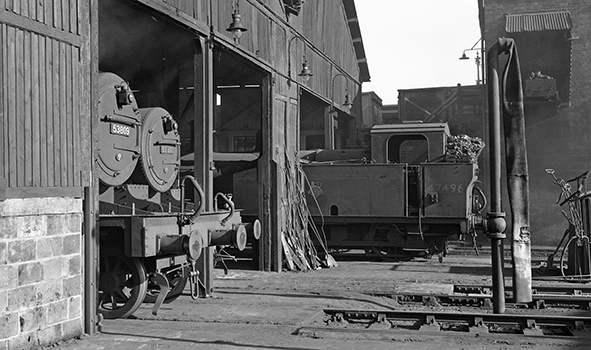British Railways The First 25 Years Volume 14: The Somerset & Dorset

British Railways The First 25 Years Volume 14: The Somerset & Dorset
J. Allan and A. Murray
224 pages. 275x215mm. Printed on gloss art paper, casebound with printed board covers.
ISBN13 9781915069382
£30.00
J. Allan and A. Murray
224 pages. 275x215mm. Printed on gloss art paper, casebound with printed board covers.
ISBN13 9781915069382
£30.00
This is the fourteenth in a series of books depicting the first 25 years of British Railways, and the first to concentrate on a single line. It covers the Somerset & Dorset, a line which captured the imagination of enthusiasts out of all proportion to its size and importance, and achieved cult status. Most attention was on the 26¼ miles between Bath and Evercreech Junction. In contrast, the line south of Templecombe to Bournemouth was very much a poor relation with enthusiasts. Except for summer Saturdays when through holiday trains ran, the Somerset & Dorset was essentially a secondary line with a reasonable amount of goods and coal traffic on the northern section. We hope to have struck a reasonable balance between the two aspects of this rather Jekyll and Hyde line. Our journey begins at Bournemouth West, joining the L&SWR main line at Branksome, passing through Poole and heading north to Broadstone Junction where the Somerset & Dorset’s own metals commenced, and then on to Blandford Forum before reaching Templecombe where the Somerset & Dorset crossed the L&SWR main line to the west country. Trains calling there used a platform in the L&SWR station, requiring some unusual shunting manoeuvres that kept enthusiasts entertained right up until closure. After visiting the engine shed, we leave Templecombe and continue northwards to Evercreech Junction, leaving the main line to travel along the branch to Highbridge and Burnham-on-Sea and the line to Wells. We resume the journey north from Evercreech Junction over the steep climb to Masbury and finally reach Bath after a journey of 71½ miles, passing over the GWR London – Bristol line before arriving at Green Park station. There we also visit the Somerset & Dorset’s principal engine shed. For the first half of the 20th century Midland Railway designs provided the bulk of the motive power with ‘2P’ 4-4-0s, 0-4-4Ts, ‘3F’ and ‘4F’ 0-6-0s, ‘3F’ 0-6-0Ts the mainstays together with the Somerset & Dorset’s own iconic ‘7F’ 2-8-0s. After 1930 LM&SR versions of the Midland Railway types arrived together with a handful of Stanier Class ‘5’ 4-6-0s. In the early 1950s came Ivatt Class ‘2’ 2-6-2Ts and for a short time, SR Bulleid Pacifics, before the first of several classes of BR Standards arrived, culminating in the use of ‘9F’ 2-10-0s in the summers of 1960-62; GWR ‘2251’ 0-6-0s and pannier tanks appeared after the Western Region takeover in 1958. After through services ended in 1962 Standard Class ‘4’ 2-6-4Ts and Ivatt 2-6-2Ts saw out the final years until closure in March 1966.


British Railways The First 25 Years Volume 14: The Somerset & Dorset - Sample Images

After the arrival of the Stanier Class ‘5’ 4-6-0s in the late 1930s the main duties of the ‘2P’ 4-4-0s were to work the local and some of the semi-fast services, and to act as assisting engines to the ‘Pines’ and many of the summer Saturday through trains. At nationalisation on 1st January 1948, there were still thirteen of them on the S&D but by the beginning of 1961 the total had fallen to seven, mainly because many of their duties had been taken over by the BR Standard Class ‘4’ 4-6-0s, and also because the arrival of the ‘9F’ 2-10-0s had reduced the need for double-heading. 1961 would be the final summer when these engines which had graced the S&D for many years, would provide assisting services. The second of the LM&SR built engines, No. 40564 heads a Bournemouth West – Templecombe semi-fast near Broadstone on Monday, 6th June 1960. It entered service in April 1928 from Derby Works and was allocated to Templecombe from nationalisation until withdrawn in February 1962. It was paired from March 1959 onwards with an ex-Compound 4-4-0 tender, No. 2839, built by the Midland Railway in 1906 and rebuilt with a new, one-piece side-sheet tank on the original underframe.

‘7F’ 2-8-0s No. 53809 and No. 53801 and ‘3F’ 0-6-0T No. 47496 slumber in the S&D shed on a sunny Sunday, 7th June 1959. The latter was built at Vulcan Foundry Ltd in February 1928 as LM&SR No. 16579 before becoming No. 7496 in August 1934. It began life on London trip and suburban work at Devons Road Shed and then spent 2 1/2 years at Cricklewood before returning to Devons Road. Its move from the Capital to more pleasant climes at Bath came in June 1945 where it stayed until withdrawn in November 1963. Peter Gray/Rail Archive Stephenson
